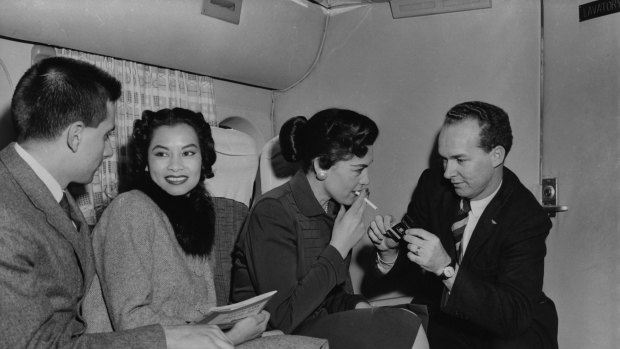This was published 9 years ago
Smoking on planes: What it was like when you could smoke on board
By JOE SHARKEY

Passengers enjoy a relaxing smoke on a Transocean Air lines Boeing 377 Stratocruiser in the mid 1950's. Transocean Air lines flew between 1946 and 1962 and was a pioneer discount airline.Credit: Getty Images
If you think the air travel experience generally stinks now, consider what it was like before smoking was banned.
Tracy Sear, a flight attendant with US Airways, was looking over some Facebook posts from colleagues recalling those bad old days when a third or more of passengers on any flight puffed away, and cabins were foul with smoke. When I spoke with her the other day, she read one of those posts to me: "Suitcases, uniforms, hair - all stunk from cigarette smoke. And it's astounding that we didn't have more cabin fires."
It's probably difficult for anyone who isn't middle-aged or older to comprehend, but people could smoke cigarettes on planes until February 25, 1990 in the US. That's when the federal government, after years of pressure from a union, the Association of Flight Attendants, finally banned smoking on all but a handful of domestic flights over six hours in duration. Ten years later, smoking was prohibited on flights between the United States and foreign destinations. Today, virtually every commercial flight in the world is smoke-free.
In Australia, the ban kicked in earlier on domestic flights - smoking was banned on December 1, 1987, making Australia the first country to implement a ban. A ban on international flights followed in 1990, a few months after the US domestic ban.
Sear's first flying job was as a flight attendant from 1968 to 1979 with Pacific Southwest Airlines, which merged into a predecessor of US Airways in the late 1980s. PSA, as it was known, marketed itself as the "World's Friendliest Airline" and outfitted its stewardesses (as they were then called) in miniskirts and go-go boots during the late 1960s.
"Then we transitioned from wool skirts to polyester hot pants, which added a whole new dimension to the smoking issue," she said, explaining: "Passengers would have their elbows on the armrest and then plop their hand out into the aisle with a lighted cigarette in it. So we would have to try to dodge it. In a wool dress, it was less of an issue because you could brush off the ash, but when PSA went to polyester hot pants you'd often get a cigarette burn hole on your pantyhose, and you were lucky not to get a more severe burn on your leg."
It was a routine chore to get the cigarette smell out of uniforms during hotel layovers, at crew crash pads or at home.
"A lot of flight attendants, particularly if their roommates didn't smoke, had to change in the garage or hang their uniforms on the balcony to air them out," Sear said.
Smells and first-degree burns aside, there were, of course, serious health hazards from intense exposure to secondhand smoke. Sara Nelson, the international president of the Association of Flight Attendants, started as a flight attendant in 1996 when smoking was still permitted on many international flights.
Even as a passenger, "I remember getting off the airplane and feeling like I had to scrape off layers and layers of ick, with eyes stinging, throat hurting and all of the other symptoms of exposure to secondhand smoke," she recalled.
The flight attendants union began fighting for a smoking ban in the late 1960s, against fierce opposition from the tobacco industry.
"It was a real uphill battle," Nelson said. "For us this was a workplace issue; we had members who were experiencing shortness of breath and all of the problems created by secondhand smoke, up to and including deadly diseases like lung cancer. We really were the tipping point that allowed for smoke-free workplaces in this country.
"The smoke would hang in the cabin right at about face level, so the whole time you are working on the flight you were breathing in smoke," Sear added.
Robin Koval, the president of Legacy, a nonprofit organisation that works to discourage tobacco use among young people, said that flight attendants' efforts were crucial in creating smoke-free workplaces for everyone.
"I was a smoker who quit in 1984, and I remember sitting on airplanes filled with smoke, all of us choking our way from New York to Los Angeles," she said. "Can you imagine spending six hours in a sealed sardine can where you are forced to breathe in toxic chemicals all day long? We wouldn't allow any kind of workers to do that today."
Most US car rental companies say their vehicles are smoke-free and charge a stiff "cleaning fee" (usually $US250) if smoking is evident in a returned vehicle. But there are, of course, still places where travellers who do not smoke routinely encounter secondhand smoke, she noted, including some casinos, bars, restaurants and hotels.
"Most airports are smoke-free, which is great," Koval said. Some have designated smoking areas but, she said, "studies have found that the smoke is not actually all contained in those smoking rooms."
On airplanes, and especially on long international flights, some passengers desperate for a smoke still try to get away with it, usually by trying to disable smoke detectors in lavatories, said Nelson of the flight attendants union.
"The first thing we have to do is make sure they haven't created a fire on board the aircraft, because a lot of times they'll throw the cigarette down into the trash bin," she said. "Then at the same time we're advising the passenger that they must comply and stop, and letting the cockpit know. Usually, the authorities will meet the flight when it lands."
THE NEW YORK TIMES
Sign up for the Traveller newsletter
The latest travel news, tips and inspiration delivered to your inbox. Sign up now.